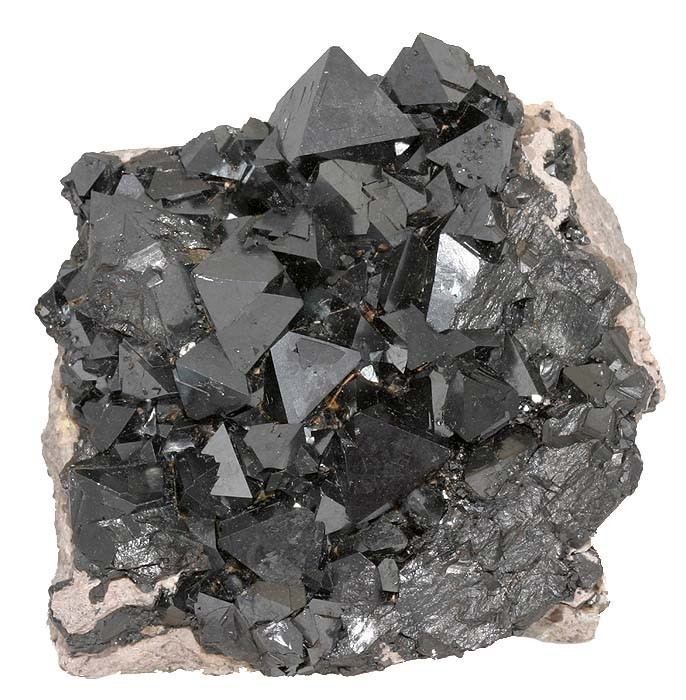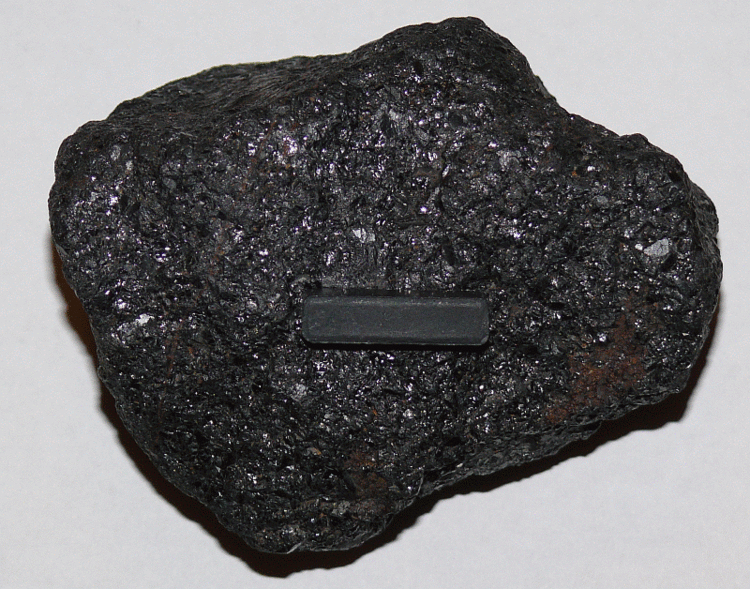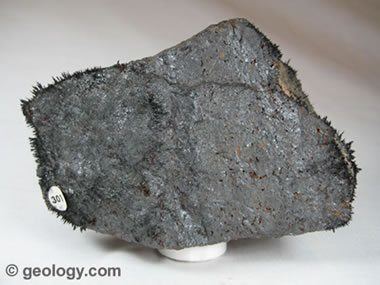Strunz classification 4.BB.05 Space group Fd3m | Crystal system Isometric | |
 | ||
Category Oxide mineralsSpinel groupSpinel structural group Formula(repeating unit) iron(II,III) oxide, FeFe2O4 Crystal class Hexoctahedral (m3m)H-M symbol: (4/m 3 2/m) | ||
Magnetite chemistry
Magnetite is a mineral and one of the main iron ores. With the chemical formula Fe3O4, it is one of the oxides of iron. Magnetite is ferrimagnetic; it is attracted to a magnet and can be magnetized to become a permanent magnet itself. It is the most magnetic of all the naturally-occurring minerals on Earth. Naturally-magnetized pieces of magnetite, called lodestone, will attract small pieces of iron, which is how ancient peoples first discovered the property of magnetism. Today it is mined as iron ore.
Contents
- Magnetite chemistry
- Properties
- Solid solutions
- Reactions
- Magnetic properties
- Distribution of deposits
- Biological occurrences
- Human brain
- Applications
- Magnetic recording
- Catalysis
- References

Small grains of magnetite occur in almost all igneous and metamorphic rocks. Magnetite is black or brownish-black with a metallic luster, has a Mohs hardness of 5–6 and leaves a black streak.
The chemical IUPAC name is iron(II,III) oxide and the common chemical name is ferrous-ferric oxide.
Properties

In addition to igneous rocks, magnetite also occurs in sedimentary rocks, including banded iron formations and in lake and marine sediments as both detrital grains and as magnetofossils. Magnetite nanoparticles are also thought to form in soils, where they probably oxidize rapidly to maghemite.
Solid solutions

Magnetite has an inverse spinel crystal structure. As a member of the spinel group, it can form solid solutions with similarly structured minerals, including ulvospinel (Fe2TiO4), hercynite (FeAl2O4) and chromite (FeCr2O4). Titanomagnetite, also known as titaniferous magnetite, is a solid solution between magnetite and ulvospinel that crystallizes in many mafic igneous rocks. Titanomagnetite may undergo oxyexsolution during cooling, resulting in ingrowths of magnetite and ilmenite.
Reactions
Magnetite has been important in understanding the conditions under which rocks form. Magnetite reacts with oxygen to produce hematite, and the mineral pair forms a buffer that can control oxygen fugacity. Commonly, igneous rocks contain solid solutions of both titanomagnetite and hemoilmenite or titanohematite. Compositions of the mineral pairs are used to calculate how oxidizing was the magma (i.e., the oxygen fugacity of the magma): a range of oxidizing conditions are found in magmas and the oxidation state helps to determine how the magmas might evolve by fractional crystallization. Magnetite also is produced from peridotites and dunites by serpentinization.
Magnetic properties
Lodestones were used as an early form of magnetic compass. Magnetite typically carries the dominant magnetic signature in rocks, and so it has been a critical tool in paleomagnetism, a science important in understanding plate tectonics and as historic data for magnetohydrodynamics and other scientific fields.
The relationships between magnetite and other iron-rich oxide minerals such as ilmenite, hematite, and ulvospinel have been much studied; the reactions between these minerals and oxygen influence how and when magnetite preserves a record of the Earth's magnetic field.
At low temperatures, magnetite undergoes a crystal structure phase transition from a monoclinic structure to a cubic structure known as the Verwey transition. The Verwey transition occurs around 121 K and is dependent on grain size, domain state, and the iron-oxygen stoichiometry. An isotropic point also occurs near the Verwey transition around 130 K, at which point the sign of the magnetocrystalline anisotropy constant changes from positive to negative. The Curie temperature of magnetite is 858 K (585 °C; 1,085 °F).
Distribution of deposits
Magnetite is sometimes found in large quantities in beach sand. Such black sands (mineral sands or iron sands) are found in various places, such as Lung Kwu Tan of Hong Kong, California of the United States and the west coast of the North Island of New Zealand. The magnetite is carried to the beach via rivers from erosion and is concentrated via wave action and currents. Huge deposits have been found in banded iron formations. These sedimentary rocks have been used to infer changes in the oxygen content of the atmosphere of the Earth.
Large deposits of magnetite are also found in the Atacama region of Chile, Valentines region of Uruguay, Kiruna, Sweden, the Pilbara, Midwest and Northern Goldfields regions in Western Australia, New South Wales in the Tallawang Region, and in the Adirondack region of New York in the United States. Kediet ej Jill, the highest mountain of Mauritania, is made entirely of the mineral. Deposits are also found in Norway, Germany, Italy, Switzerland, South Africa, India, Indonesia, Mexico, Hong Kong, and in Oregon, New Jersey, Pennsylvania, North Carolina, West Virginia, Virginia, New Mexico, Utah, and Colorado in the United States. In 2005, an exploration company, Cardero Resources, discovered a vast deposit of magnetite-bearing sand dunes in Peru. The dune field covers 250 square kilometers (100 sq mi), with the highest dune at over 2,000 meters (6,560 ft) above the desert floor. The sand contains 10% magnetite.
Biological occurrences
Biomagnetism is usually related to the presence of biogenic crystals of magnetite, which occur widely in organisms. These organisms range from bacteria (e.g., Magnetospirillum magnetotacticum) to animals, including humans, where magnetite crystals (and other magnetically-sensitive compounds) are found in different organs, depending on the species. Biomagnetites account for the effects of weak magnetic fields on biological systems. There is also a chemical basis for cellular sensitivity to electric and magnetic fields (galvanotaxis).
Pure magnetite particles are biomineralized in magnetosomes, which are produced by several species of magnetotactic bacteria. Magnetosomes consist of long chains of oriented magnetite particle that are used by bacteria for navigation. After the death of these bacteria, the magnetite particles in magnetosomes may be preserved in sediments as magnetofossils.
Several species of birds are known to incorporate magnetite crystals in the upper beak for magnetoreception, which (in conjunction with cryptochromes in the retina) gives them the ability to sense the direction, polarity, and magnitude of the ambient magnetic field.
Chitons, a type of mollusk, have a tongue-like structure known as a radula, covered with magnetite-coated teeth, or denticles. The hardness of the magnetite helps in breaking down food, and its magnetic properties may additionally aid in navigation. It has also been proposed that biological magnetite may store information.
Human brain
There is also evidence that magnetite exists in the human brain, where it is theorized to affect long-term memory. Some researchers also suggest that humans possess a magnetic sense, proposing that this could allow certain people to use magnetoreception for navigation. The role of magnetite in the brain is still not well understood, and there has been a general lag in applying more modern, interdisciplinary techniques to the study of biomagnetism.
Electron microscope scans of human brain-tissue samples are able to differentiate between magnetite produced by the body's own cells and magnetite absorbed from airborne pollution, the natural forms being jagged and crystalline, while magnetite pollution occurs as rounded nanoparticles. In some brain samples, the nanoparticle pollution outnumbers the natural particles by as much as 100:1, and such pollution-borne magnetite particles may be linked to abnormal neural deterioration. In one study, the characteristic nanoparticles were found in the brains of 37 people: 29 of these, aged 3 to 85, had lived and died in Mexico City, a significant air pollution hotspot. A further eight, aged 62 to 92, came from Manchester, and some had died with varying severities of neurodegenerative diseases. According to researchers led by Prof. Barbara Maher at Lancaster University and published in the Proceedings of the National Academy of Sciences, such particles could conceivably contribute to diseases like Alzheimer's disease. Though a causal link has not been established, laboratory studies suggest that iron oxides like magnetite are a component of protein plaques in the brain, linked to Alzheimer's disease.
Applications
Due to its high iron content, magnetite has long been a major iron ore. It is reduced in blast furnaces to pig iron or sponge iron for conversion to steel.
Magnetic recording
Audio recording using magnetic acetate tape was developed in the 1930s. The German magnetophon utilized magnetite powder as the recording medium. Following World War II, the 3M company continued work on the German design. In 1946, the 3M researchers found they could improve the magnetite-based tape, which utilized powders of cubic crystals, by replacing the magnetite with needle-shaped particles of gamma ferric oxide (γ-Fe2O3).
Catalysis
Magnetite is the catalyst for the industrial synthesis of ammonia.
